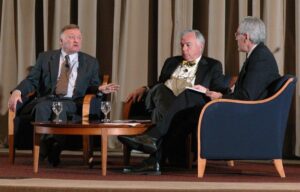If you like spy stories, check out this non-fiction book (get it here) about CIA spycatchers and double agents, written by an ex-CIA officer (he cleared its contents with the Agency). It’s not dense or tedious; it’s fun to read.
“The Fourth Man” is a newly released book (publication date: May 17, 2022), and is up-to-date on current events.
The title refers to a possible Russian spy inside the CIA who was never caught, and potentially was the most damaging traitor in America’s history. The book describes a CIA spycatcher team’s years-long search for him. It explains how “mole hunters” do their work, and offers some details about spying “tradecraft.” (For example, an “incontinent” dog can provide an alibi for going on middle-of-the-night walks in a local park where a “dead drop” site is located.)
Most people have heard of Aldrich Ames and Robert Hanssen, who were arrested and convicted, and some perhaps of Edward Howard, who defected to Russia and died there. They’re the three big turncoats (Ames and Howard at the CIA, Hanssen at the FBI) responsible for the destruction of America’s spy network in Russia in the 1980s and 1990s. Their betrayals got numerous Russians spying for the CIA executed, and turned Russia into an information black hole for a couple of decades. But other, unexplained, betrayals and compromises led the CIA to suspect there was a fourth traitor, which led to launching the “mole hunt” detailed in this book.
In consequence, one of the things America didn’t see coming was Putin, an ex-KGB agent who emerged from the dark bowels of the KGB and seized power in Russia. He stays in power, untouchable, largely because of the KGB, whose power was largely untouched by the fall of the Soviet Union. That name isn’t used anymore, it’s called by other names now, but little else has changed; and Putin’s Russia is as much a police state as the USSR during the Cold War.
This book focuses on spies who worked for intelligence agencies. The CIA and KGB actively worked to recruit each other’s agents as double agents. It explains why they do it: It’s often for money, but can be for other reasons, e.g. ideology or revenge for being denied promotion.
Another revelation of this book is that Russia is a legalistic society. Most Americans assume the KGB summarily executes traitors, but in fact Russia runs them through their legal system, and gives them a semblance of due process, before executing them. (And yes, Russia executes their people who spy for the Americans, British, French, etc.)
The author is a CIA veteran, and he isn’t kind to his former employer. He portrays the CIA as a bureaucracy run by incompetents, and flatly says Russia is better at spying than we are. And he spares no cynicism in describing what CIA careers were like: The backbiting, intrigues, power struggles, personality conflicts, and destruction of careers that went on in the background. I came away from this book thinking, “I’m sure glad I didn’t choose a CIA career.” This book will not work as a CIA recruiting tool.
As for the Fourth Man, who may or may not have existed, it’s not that the CIA didn’t want to catch him; it was more a matter of the top brass wanting him to never have existed. See no evil, hear no evil, speak no evil. The Agency’s institutional interests were better served if nothing came of the spycatchers’ suspicions there was another CIA double agent besides Ames and Howard who, if he did exist, got away. But the author, and others close to the situation, are convinced he did exist.
The brass didn’t sandbag the investigation, but weren’t enthusiastic about it, either. The evidence pointed to the uncaught spy being someone on “the seventh floor,” where the CIA’s upper management resides. And that’s precisely what made it so hard to track him.
Related article: The U.S. keeps losing wars because its political leaders don’t listen to spies, a writer on military subjects argues here.
Photo below: Paul Redmond, center, a CIA chief of counterintelligence during events described in the book, denies he was the “Fourth Man” (see story here). At left is Oleg Kalugin, a former KGB agent and Putin critic who settled in the U.S., but denied ever spying for the CIA. The man on the right is an event moderator.
